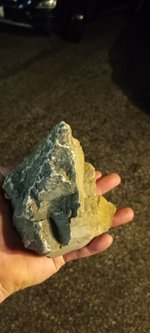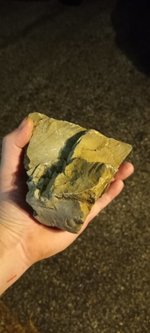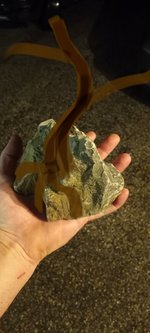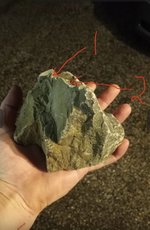You are using an out of date browser. It may not display this or other websites correctly.
You should upgrade or use an alternative browser.
You should upgrade or use an alternative browser.
Found a Rock Last Summer
- Thread starter just.wing.it
- Start date
John P.
Chumono
just.wing.it
Deadwood Head
Yeah indeed... I want that point to protrude from the roots, not have a cherry on a sundae.Looks good. Could be nice for a trident. Just don’t do the “root on the top of a rock” thing.
View attachment 418832
And having it offset to a side, definitely.
River's Edge
Masterpiece
I like the change in shape of the rock, but I have a preference for darker colours when creating root over rock designs. This rock looks similar to some I collected and then discarded later after checking them with various tree bark combinations. The white " quartz " veins were lovely in contrast with the green tone of the rock, but I found the overall tone " light in colour". particularly after washing the debris off the rocks and letting them dry! In other words I thought the rock would stand out rather than complement the tree.I think it has a good shape and flat bottom...but its a little small.
I still may try a ROR project with it....
View attachment 418829View attachment 418830View attachment 418831
Thoughts?
By change in shape I am referring to the flatter base, shelf for positioning a root ball to the side and some additional character " uniquesness" All good characteristics for root over rock.
The only other comment would be that trident is a very vigorous species and a larger rock might be better considered for an eventual design and size for trident maple.
Just some thoughts.
just.wing.it
Deadwood Head
Much appreciated....I like the change in shape of the rock, but I have a preference for darker colours when creating root over rock designs. This rock looks similar to some I collected and then discarded later after checking them with various tree bark combinations. The white " quartz " veins were lovely in contrast with the green tone of the rock, but I found the overall tone " light in colour". particularly after washing the debris off the rocks and letting them dry! In other words I thought the rock would stand out rather than complement the tree.
By change in shape I am referring to the flatter base, shelf for positioning a root ball to the side and some additional character " uniquesness" All good characteristics for root over rock.
The only other comment would be that trident is a very vigorous species and a larger rock might be better considered for an eventual design and size for trident maple.
Just some thoughts.
I'm still pondering species...
To my eyes, it looks on the small side for root over rock unless you’re aiming for quite a small tree. The rock has some nice character to it though and looks like a mountain in miniature. Maybe it would be usable for suiseki?
Huggz13
Mame
Looks like limestone rip rap.
It’s used for erosion control along slopes, shorelines and drainage ditches.
Tons of it here in NW Florida.
I use them in my planted aquariums because those calcite veins reflect the light and create a cool shimmer effect.
It’s used for erosion control along slopes, shorelines and drainage ditches.
Tons of it here in NW Florida.
I use them in my planted aquariums because those calcite veins reflect the light and create a cool shimmer effect.
penumbra
Imperial Masterpiece
My first thought as well.To my eyes, it looks on the small side for root over rock unless you’re aiming for quite a small tree. The rock has some nice character to it though and looks like a mountain in miniature. Maybe it would be usable for suiseki?
It is a nice rock.
Huggz13
Mame
Does kinda look like a little mini Everest.To my eyes, it looks on the small side for root over rock unless you’re aiming for quite a small tree. The rock has some nice character to it though and looks like a mountain in miniature. Maybe it would be usable for suiseki?
There’s the vertical Hillary Step right before the summit (1), and the flat North col - home of Camp 4 (2).
Yeah, I need to go to bed haha
Attachments
River's Edge
Masterpiece
Below are a few of the notes I used for a handout in a root over rock workshop. They may generate some ideas or assist others reading this thread. The workshop was targeted to use Trident maple as the tree of choice in this particular case. So medium to larger rocks were used. I always stress to pay particular attention to point #2 in choosing a tree. The younger saplings have very flexible roots that grow quickly and with proper binding will form tightly to the rock form. One of the most important considerations for best outcomes. For example we used two and three year old trident from seed that had some root work previously done to promote more lateral roots.Much appreciated....
I'm still pondering species...
Guidelines to consider include the following:
The goal is to create a unified presentation of the rock and tree where one does not compete with the other. It should look like it might have occurred naturally rather than imposed artificially.
Choosing the rock
- Size is important and should balance the tree design. Remember it will not change.
- Stone should not compete for attention with the tree, choose darker muted tones.
- Desirable characteristics include, weathered, rougher texture, fissures and creases.
- Choose stones that provide a planting platform off centre if possible.
- Choose stones with a stable base for planting.
- Look for unique characteristics.
- Choose a species that will withstand bare rooting and forms strong roots.
- Choose a younger specimen to aid balancing the development.
- Choose a base that has or can have movement and taper introduced.
- Choose a species that will allow for refinement and smaller scale.
- Do not mask too many natural features of the stone.
- Avoid perching the tree on the peak
- Look for the best combination of line and mass.
- Develop both the tree and roots in balance.
just.wing.it
Deadwood Head
That's great! Thanks!Below are a few of the notes I used for a handout in a root over rock workshop. They may generate some ideas or assist others reading this thread. The workshop was targeted to use Trident maple as the tree of choice in this particular case. So medium to larger rocks were used. I always stress to pay particular attention to point #2 in choosing a tree. The younger saplings have very flexible roots that grow quickly and with proper binding will form tightly to the rock form. One of the most important considerations for best outcomes. For example we used two and three year old trident from seed that had some root work previously done to promote more lateral roots.
Guidelines to consider include the following:
The goal is to create a unified presentation of the rock and tree where one does not compete with the other. It should look like it might have occurred naturally rather than imposed artificially.
Choosing the rock
Choosing the Tree
- Size is important and should balance the tree design. Remember it will not change.
- Stone should not compete for attention with the tree, choose darker muted tones.
- Desirable characteristics include, weathered, rougher texture, fissures and creases.
- Choose stones that provide a planting platform off centre if possible.
- Choose stones with a stable base for planting.
- Look for unique characteristics.
Design Considerations
- Choose a species that will withstand bare rooting and forms strong roots.
- Choose a younger specimen to aid balancing the development.
- Choose a base that has or can have movement and taper introduced.
- Choose a species that will allow for refinement and smaller scale.
- Do not mask too many natural features of the stone.
- Avoid perching the tree on the peak
- Look for the best combination of line and mass.
- Develop both the tree and roots in balance.
Wires_Guy_wires
Imperial Masterpiece
Thats a nice rock.
rockm
Spuds Moyogi
Better suiseki than a candidate for ROR...
SeanS
Omono
- Messages
- 1,241
- Reaction score
- 3,484
- USDA Zone
- 9b
Not a bad rock, but if you only have one rock and only plan on creating one ROR I’d look for something a bit more interesting. Here are (only) some of the rocks I used to start ROR project this season. I had quite a selection and loads of JM and trident seedlings so could play around with different styles of ROR. Some are basic rounded rocks with trees emerging on one side and cascading over the top of the rock, some are more upright but still quite squat with the roots sprawling all over the surface of the rocks. Some are upright, tall and skinny, with the trees perched on top.
Some are really small for shohin trees, while the largest is close to 30cm tall.
Some are really small for shohin trees, while the largest is close to 30cm tall.
just.wing.it
Deadwood Head
There's a good point that I hadn't considered....!Better suiseki than a candidate for ROR...
penumbra
Imperial Masterpiece
Honestly, that was my first thought when I saw the piece, but it is a bit rough. Not that this bothers me, but it would bother a lot of collectors.
It would also look great in a Penjing composition.................
Or even just sitting there on the bonsai bench.
It would also look great in a Penjing composition.................
Or even just sitting there on the bonsai bench.
Dragon60
Shohin
My vote is suiseki. The first pic reminds me of a mountain with snow on it.
Similar threads
- Replies
- 22
- Views
- 2K
- Replies
- 16
- Views
- 2K
- Replies
- 5
- Views
- 10K





